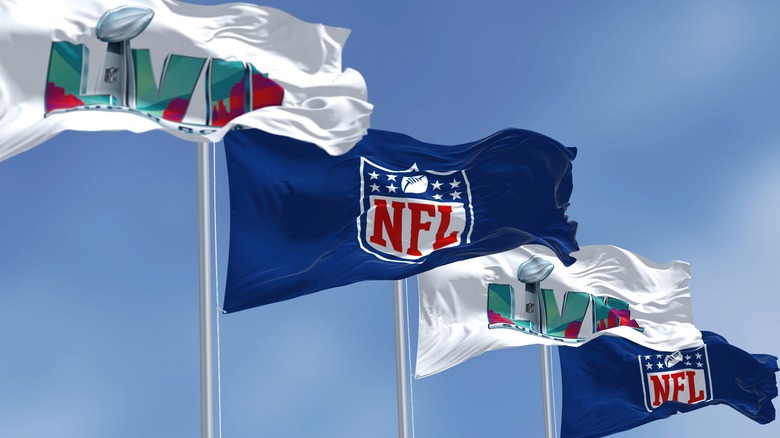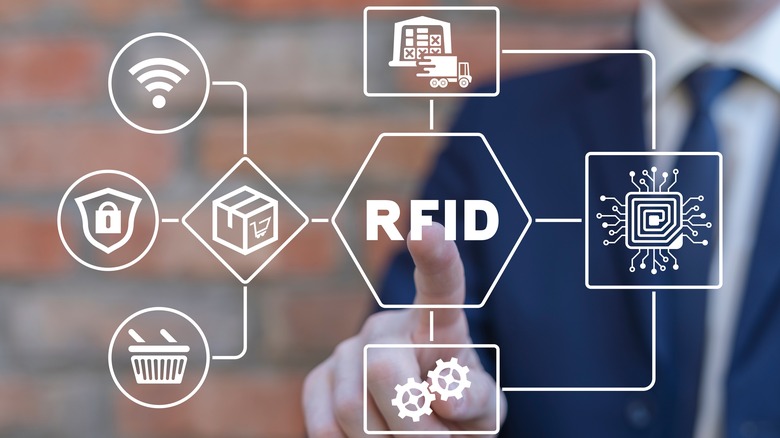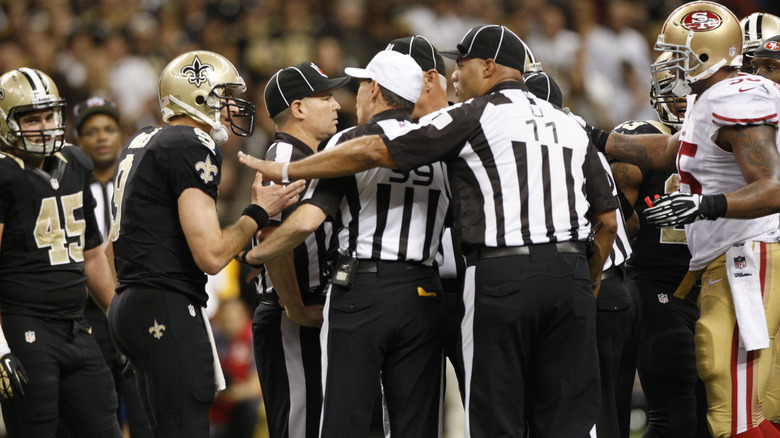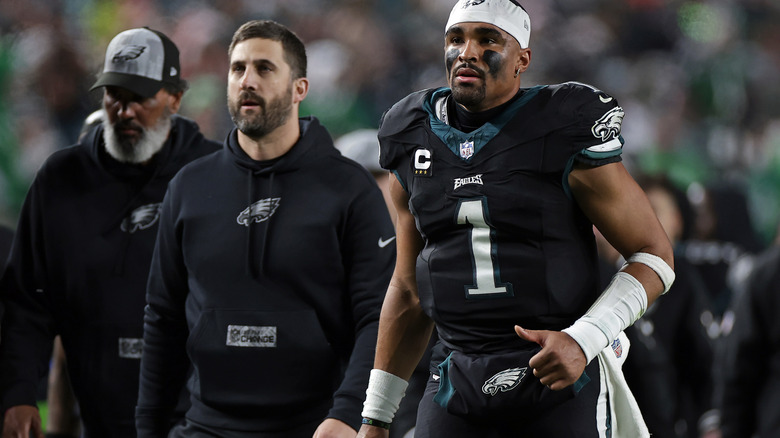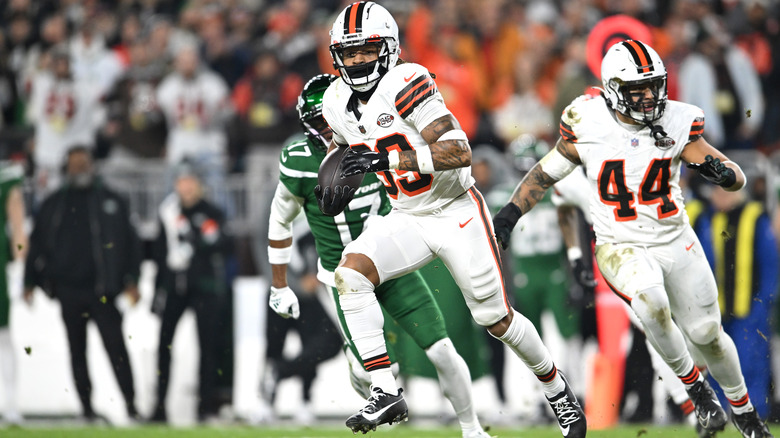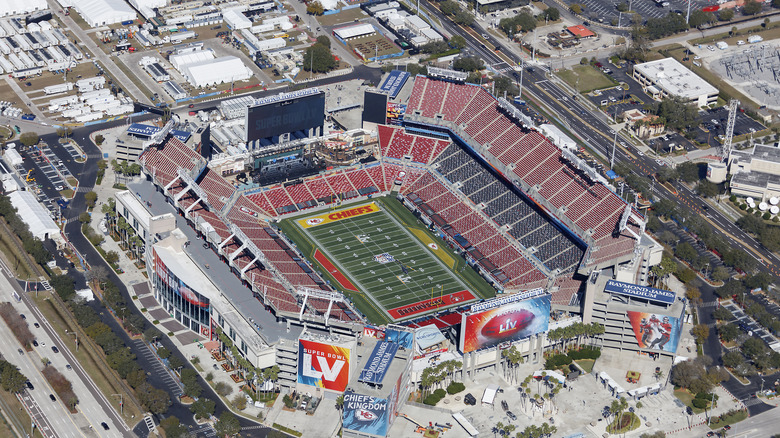Here's How The NFL's Next Gen Stats Technology Actually Works (And How It's Changed The Game)
As time goes by and technology improves, it begins to seep its way into every crevice of daily life. As long as humans have been playing sports, they have been keeping score. In the center of these two statements is the NFL's Next Gen Stats, a dizzying amount of statistics that the NFL publishes about teams and players throughout the season. Almost any statistic you could ever want to know about any team and any player is knowable and has been meticulously recorded.
Gone are the days when assessing a player's performance relied solely on subjective observations or basic statistics. The NFL's Next Gen Stats program has made way for a new level of precision and insight within data that goes far beyond the surface-level metrics. This comprehensive system has not only enriched the viewing experience for fans but has also provided teams with a treasure trove of information to inform strategic decisions and player development. The ability to quantify the seemingly unquantifiable has not only heightened the enjoyment of the game for enthusiasts but has also armed coaches and players with invaluable insights, refining strategies, and elevating the overall quality of play.
The only question is, how do they capture so much data? The answer is, of course, through dizzying technology. The intersection of athleticism and technology has never been more fascinating than in the case of the NFL's Next Gen Stats. Through this program, the NFL has implemented a whole lot of technology, and the newly available stats this tech has created have changed the way football is played.
The history behind the tech
The roots of the technology powering the NFL's Next Gen Stats can be traced back to the early endeavors of the league to enhance the understanding of player performance through data. While football has long been recognized primarily for being an extremely physical sport, the incorporation of advanced technology into the game has been a gradual and transformative process.
The origin of the Next Gen Stats program came in 2014. Collaborating with technology partners such as Zebra Technologies, the NFL embraced a more comprehensive and precise approach to player tracking. Zebra's RFID tags were integrated into players' shoulder pads, providing real-time data on player movements, speed, and positioning during games.
This marked a quantum leap in the league's ability to capture and analyze on-field dynamics. The RFID system, with its ability to record data at a rate of 10 times per second, paved the way for a deeper understanding of player performance, strategic nuances, and game trends. Fans and analysts were suddenly equipped with a wealth of information that transcended traditional statistics. By 2017, every team in the NFL was tagged for the Next Gen Stats collection.
As the Next Gen Stats program evolved, so did the technology underpinning it. The NFL over time would deploy additional sensors to enhance the granularity of data collected. This upgraded system enabled the measurement of player orientation, acceleration, and deceleration, opening new frontiers in the analysis of player biomechanics and performance.
The technological evolution did not stop there. The NFL's collaboration with Second Spectrum brought forth the "True View" system, employing computer vision and artificial intelligence to generate immersive 360-degree replays. This not only enriched the viewing experience for fans but also provided coaches with unprecedented insights into the intricacies of play execution.
How is the information collected?
The beating heart of the NFL's Next Gen Stats lies in its ability to capture the intricacies of players' movements on the field with unparalleled precision. At the core of this capability is a sophisticated system of data collection mechanisms that work in harmony to record every move, acceleration, and strategic decision made during the course of a game.
The backbone of the data collection process is the aforementioned RFID technology embedded within players' shoulder pads. Developed in collaboration with Zebra Technologies, these RFID tags serve as beacons, emitting signals that are picked up by an array of receivers strategically positioned throughout the stadiums. This intricate web of receivers forms an extensive network designed to triangulate the location of each player on the field in real time.
As previously mentioned, the RFID chips have a transmission rate of 10 times per second. This high frequency enables the system to capture the minutest details of a player's movements, providing a comprehensive dataset that goes beyond traditional statistics. From the speed at which a receiver dashes down the sideline to the precise angles taken by a linebacker in pursuit, the RFID technology offers a meticulous understanding of player dynamics.
Beyond individual player tracking, the Next Gen Stats program extends its reach to the football itself. Special RFID tags are inserted into game balls, enabling the measurement of key parameters such as velocity, spin rate, and trajectory. This not only adds a new layer to the analysis of passing and kicking dynamics but also allows for a deeper understanding of how weather conditions or equipment variations may influence the game.
Amazon Web Services support
It's easy to think of Amazon as just a shopping website, but Amazon Web Services is actually the company's largest asset. Amazon outages affect much of the internet, and it's due to the far reach of AWS. That reach even extends to the NFL and the Next Gen Stats program. Within Next Gen Stats, the role of data analytics and cloud computing cannot be overstated. AWS serves as the backbone of the Next Gen Stats program's data infrastructure, providing a robust and scalable cloud computing platform that can handle the massive influx of real-time data from stadiums across the league. The sheer volume and complexity of the information generated by the RFID tags demand high-performance computing, and AWS delivers precisely that.
The cloud-based architecture offered by AWS enables the NFL to seamlessly process and store data in real-time. As players move on the field, their every step, sprint, and maneuver are transmitted to AWS servers, where the information is rapidly ingested, processed, and made available for analysis. This instantaneous flow of data provides players, coaches, and couch coaches with a nearly overwhelming avalanche of detail about the game being played.
One of the standout features of AWS in the Next Gen Stats program is its ability to provide near-instantaneous access to a vast array of statistical metrics. Generating data dashboards for various teams used to take several hours, but with services provided by AWS, the process now takes mere minutes. Fans, analysts, and broadcasters benefit from a user-friendly interface that taps into the wealth of data stored in the cloud.
Machine learning
The true core of the NFL's Next Gen Stats program, as it stands today, lies within machine learning. While there are certainly some questions about the future trends of AI, the NFL's use of machine learning with AWS dates back to 2017.
Machine learning algorithms are harnessed by the NFL to dissect the colossal volume of data generated by the RFID tags across each field and in players' equipment. These algorithms sift through the mountain of data, identifying exact measurements, player tendencies, and strategic patterns that can elude the human eye. The result is a deeper, more nuanced understanding of player performance and game dynamics.
One of the primary applications of machine learning in the Next Gen Stats program is player tracking and movement analysis. Algorithms process the continuous stream of spatial data creating detailed profiles of each player's on-field behavior. This goes beyond simple metrics like speed or distance covered; machine learning enables the identification of unique movement patterns, helping teams understand how players navigate the field and make split-second decisions.
This kind of synthesis of machine learning and data is best seen in the new "Pressure Probability" stat from the NFL and AWS. This stat leverages over 90,000 plays worth of data to analyze pressures in a quantifiable sense. In football, pressures are generally when a defender makes the offense's quarterback move to avoid them, or when the defender hits or sacks the quarterback before or during their pass. Pressure Probability can quantify this whole process into a percentage based on analysis of individual players, as well as the match-up between two specific players.
Beyond individual play analysis, machine learning algorithms contribute significantly to team strategy. Coaches can leverage these algorithms to assess opponent tendencies, predict play outcomes, and optimize game plans.
What kind of stats are gathered?
In the realm of professional football, the era of simplistic box score metrics has given way to a more sophisticated understanding of player performance with Next Gen Stats. It's only natural to wonder just what kind of exact data is gathered.
Next Gen Stats captures the speed and acceleration of every player on the field in real time. These metrics provide a dynamic understanding of how players navigate the game, helping to discern bursts of speed, sudden accelerations, and changes in velocity. The RFID tags' precision enables the tracking of a player's route-running with unprecedented accuracy. Coaches and analysts can delve into the subtleties of a receiver's movements, examining the efficiency of cuts and breaks in real time. The ability to measure the distance between offensive players and their defenders sheds light on the effectiveness of receivers in creating separation. This statistic is invaluable in assessing a player's skill in eluding coverage and creating opportunities for receptions.
Quarterback decision-making is brought to the forefront with the metric of time to throw. This stat quantifies the amount of time a quarterback takes from receiving the snap to releasing the ball, offering insights into their ability to read defenses and make quick decisions. The tracking of air yards, the distance the football travels through the air, and yards after catch, the distance gained by the receiver after making a reception, paints a comprehensive picture of passing efficiency and the playmaking abilities of receivers.
The vast majority of the aforementioned stats are available to view on the NFL's Next Gen Stats website. On the site, you can view exact plays as well as elaborate tables of data from various seasons that can be organized to your heart's content for any number of minute statistics.
Using the stats
The wealth of data generated by the NFL's Next Gen Stats program isn't just a collection of numbers for stat trackers to keep up with, it's also a strategic arsenal that teams and coaches leverage to gain a competitive edge on the gridiron. The real-time insights provided by these advanced analytics are instrumental in shaping game plans, player development strategies, and even in-game decisions.
Coaches can delve into the rich repository of Next Gen Stats to inform their play-calling strategies. The ability to analyze opponent tendencies, player movement patterns, and defensive reactions empowers the coaching staff to tailor their plays with a level of precision that was previously unparalleled. The dynamic nature of football demands quick thinking and adaptability. Next Gen Stats provides coaches with real-time data that enables them to make on-the-fly adjustments based on the unfolding dynamics of the game. Whether tweaking defensive formations or altering offensive strategies, the insights gleaned from Next Gen Stats contribute to a more adaptive approach.
Beyond the immediate demands of a single game, Next Gen Stats contribute to long-term player development strategies. The granular data on biomechanics, acceleration, and deceleration can inform training programs, helping players optimize their physical performance and reduce the risk of injuries. Next Gen Stats can also play a pivotal role in the evaluation of potential draft picks and free-agent acquisitions. Teams can utilize the data to identify players whose skill sets align with the team as it stands.
How Next Gen Stats have changed the game
From the strategies devised on the sidelines to the way fans engage with the sport, the impact of advanced statistics has been nothing short of revolutionary. Next Gen Stats have paved the way for a more diverse and innovative playbook. Coaches, armed with granular insights into player movements and tendencies, are devising strategic plays that exploit opponents' weaknesses with surgical precision. The result is a game that showcases a broader spectrum of offensive and defensive tactics, adding layers of complexity and excitement.
Next Gen Stats have not only changed the game for players and coaches but also for the fans. The integration of advanced analytics into broadcasts and digital platforms has elevated the fan experience. Viewers now have access to a wealth of statistical information that deepens their understanding of the game, fostering a more engaged and knowledgeable fan base.
Machine learning and simulation through AWS both play a crucial role in player wellness and injury prevention. Teams can monitor players' physical exertion levels, assess recovery needs, and identify potential injury risks. This proactive approach to player health is contributing to a more sustainable and injury-conscious game.
A new level of strategy
Armed with Next Gen Stats, coaches are tailoring their play calling with surgical precision. The ability to analyze opponent tendencies, defensive reactions, and player movements allows for the creation of plays that exploit specific weaknesses, resulting in a strategic depth that was once elusive. While it's easy to think of football as a purely physical game, there has always been strategy at play. Equipped with Next Gen Stats, teams can take strategy to unprecedented levels.
Next Gen Stats have influenced game management strategies, particularly in critical moments. Coaches can make more informed decisions regarding clock management, timeouts, and crucial in-game situations based on real-time player data. This data-driven approach enhances the probability of success in high-stakes moments. Next Gen Stats provide real-time situational awareness that guides decision-making on every down. Coaches can assess the optimal play based on factors such as field position, down and distance, and player fatigue. This heightened awareness translates into a more nuanced and strategic approach to every phase of the game.
The granularity of player tracking data enables teams to optimize player matchups. Coaches can identify favorable one-on-one situations based on speed differentials, route-running efficiency, and defensive reactions. Defensive strategies have become more adaptive and responsive. Defensive coordinators, armed with insights into offensive tendencies and player movements, can adjust formations and coverage schemes in real time. This adaptability is a game-changer, allowing defenses to disrupt offensive plays with calculated precision.
Coaches are using Next Gen Stats to assess the risk associated with various decisions. Whether a fourth down play or a two-point conversion, the ability to analyze player metrics and defensive formations aids in decision-making that is more calculated and strategic.
The future of Next Gen Stats
As the NFL's Next Gen Stats program continues to redefine the boundaries of football analytics, the trajectory of its future promises a landscape of even greater innovation and transformative potential. The evolution witnessed thus far is merely a prelude to what lies ahead, as emerging technologies and strategic applications set the stage for the next chapter in the intersection of football and data.
The next frontier for Next Gen Stats is likely to involve the integration of biometric data into player analytics. Real-time monitoring of vital signs, fatigue levels, and physiological responses could provide a more comprehensive understanding of player well-being and performance, fostering a proactive approach to health management.
Machine learning algorithms are poised to become even more sophisticated, offering predictive insights that extend beyond individual plays. Teams may harness AI to predict entire game outcomes, simulate strategic scenarios, and optimize their overall performance throughout the season.
The future of fan engagement may see the incorporation of augmented reality experiences fueled by Next Gen Stats. Fans could immerse themselves in interactive, data-rich environments, experiencing the game in ways previously unimaginable. AR overlays during broadcasts could provide viewers with real-time player insights and statistical analyses.
Biomechanical data captured by Next Gen Stats may play a pivotal role in tailoring personalized training regimens for players. The insights derived from player movements and physical exertion could inform targeted development programs, optimizing player performance and potentially extending careers.
The influence of Next Gen Stats may extend to lower levels of football, influencing coaching methodologies and player development programs in youth and college football. Aspiring athletes could benefit from early exposure to data-driven insights, shaping the future generation of players.
